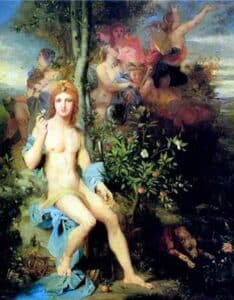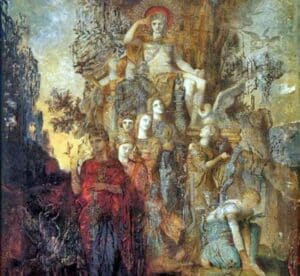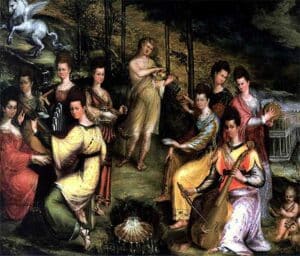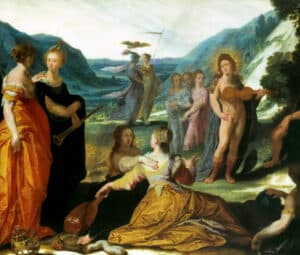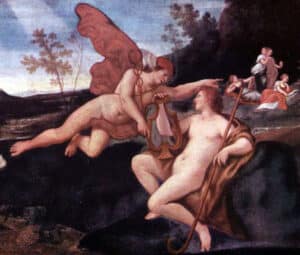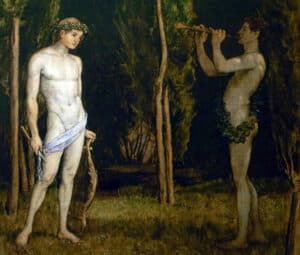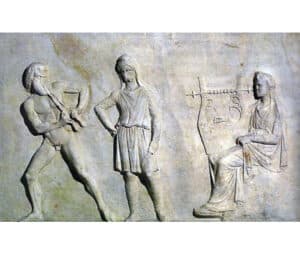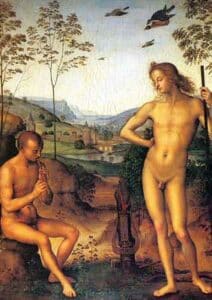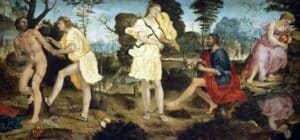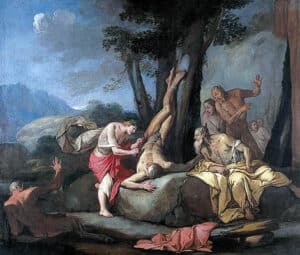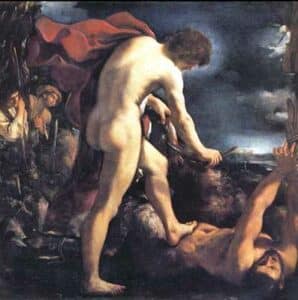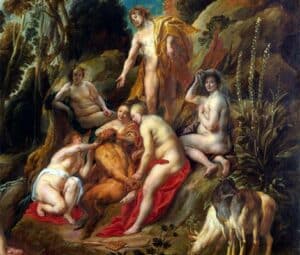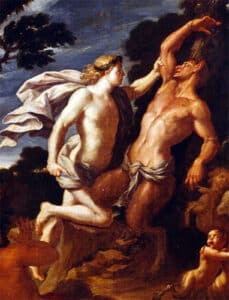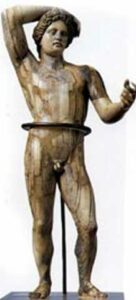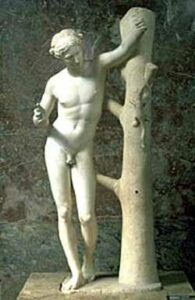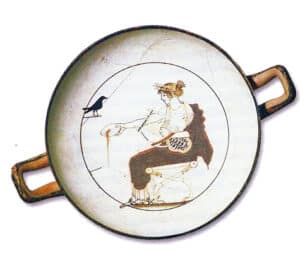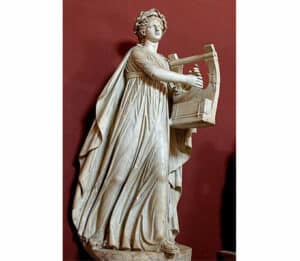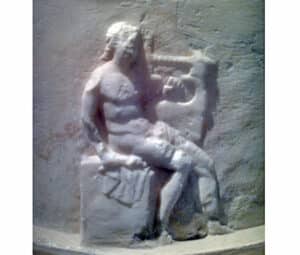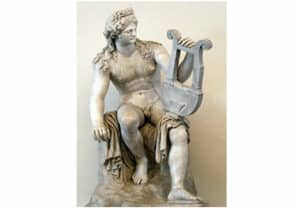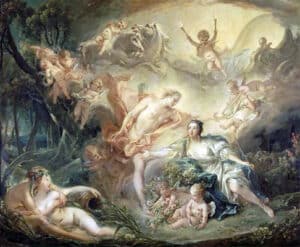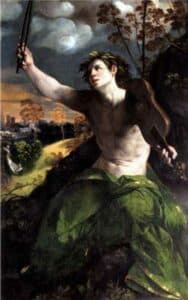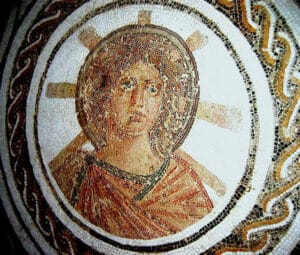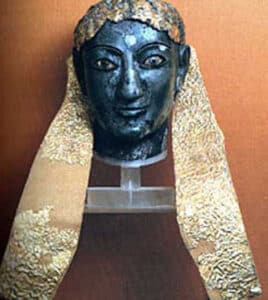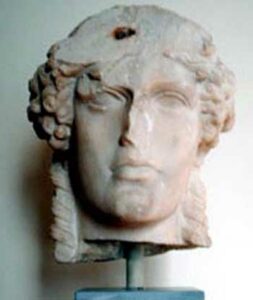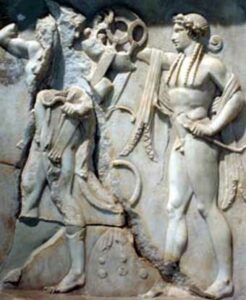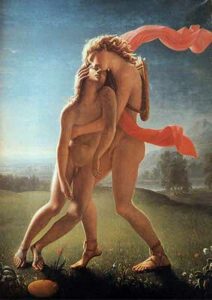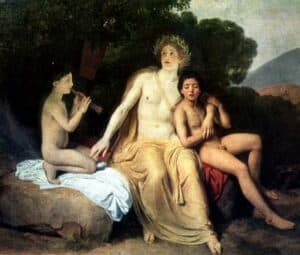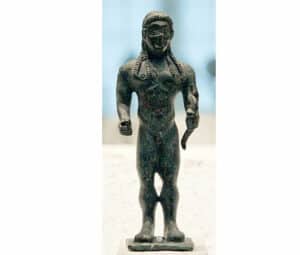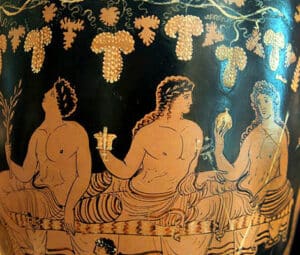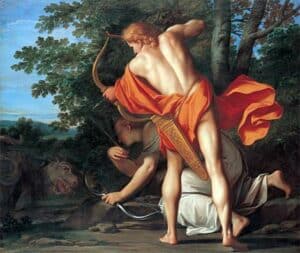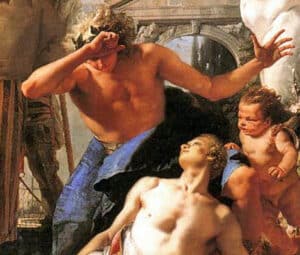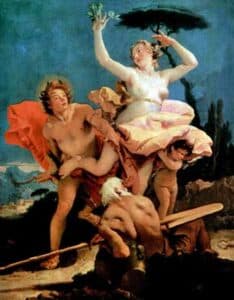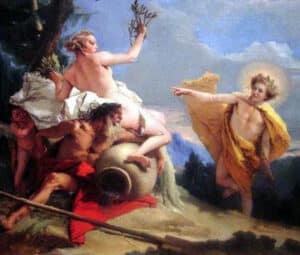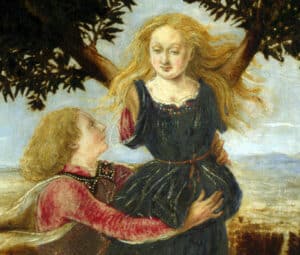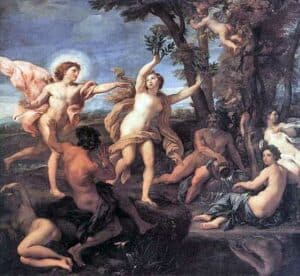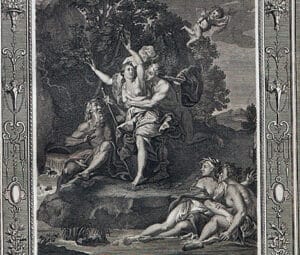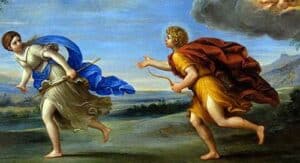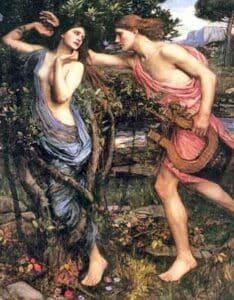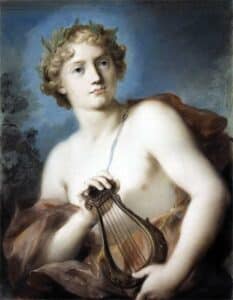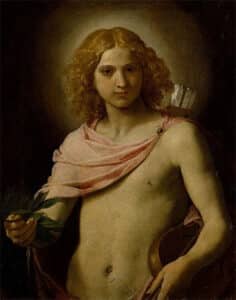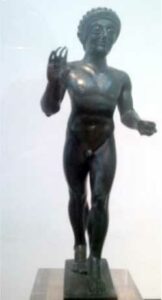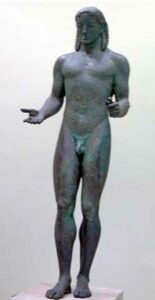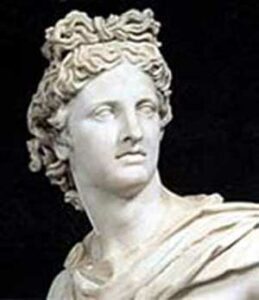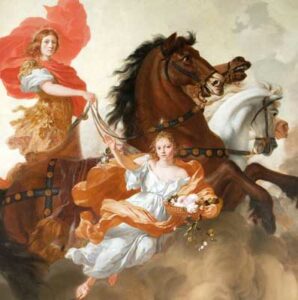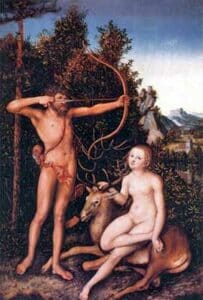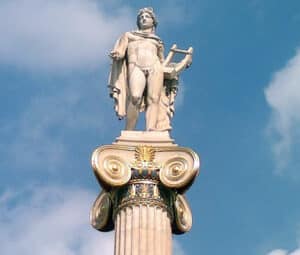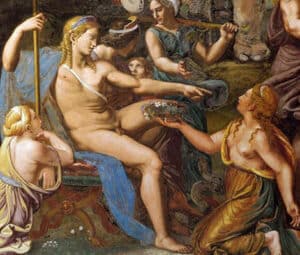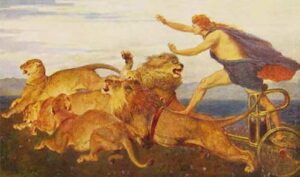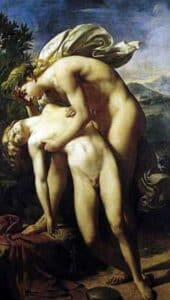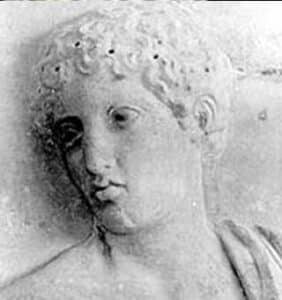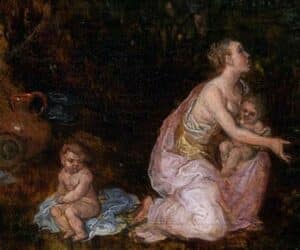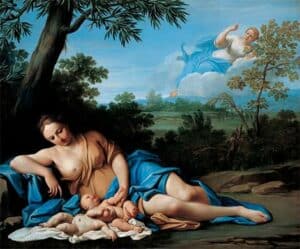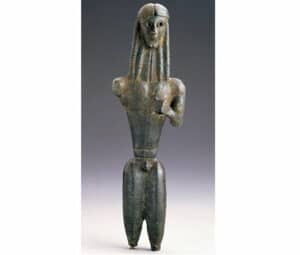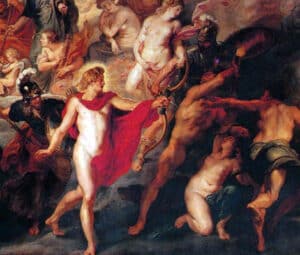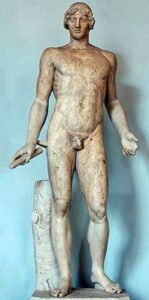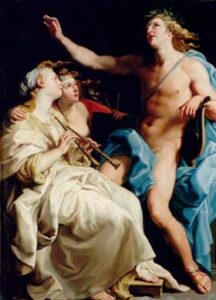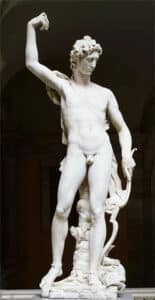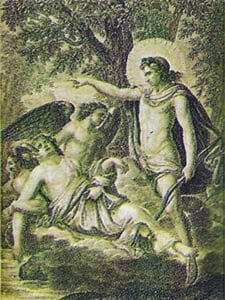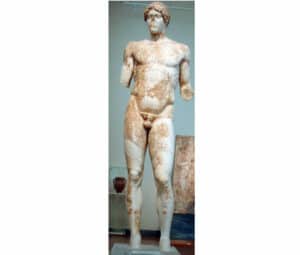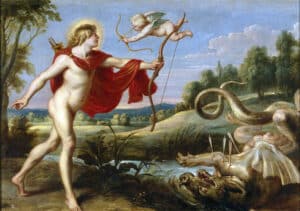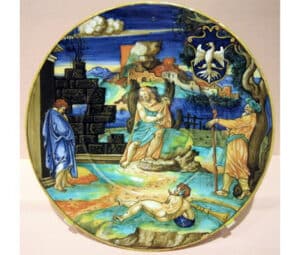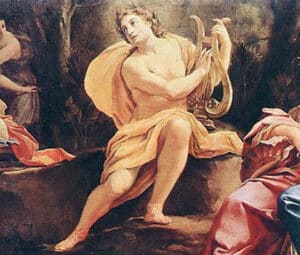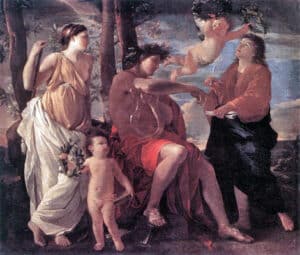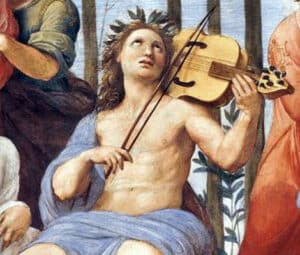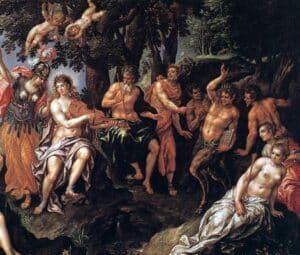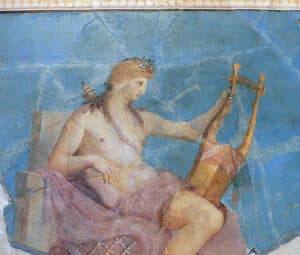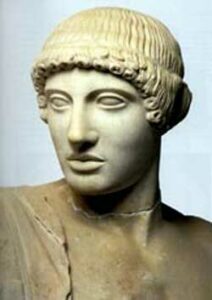Apollo, the Olympian God of the Arts, Prophecies, Oracles, the Sun and Light, Healing and Disease, was a gentle figure in the Olympic Pantheon. He was also responsible for protecting the young and was the eternal ephebe. His sacred symbols included his lyre, arrows and bow, laurel, cypress tree, raven, swan, wolf, and python.
Key Facts
Family tree
| Parents | Zeus and Leto |
| Partner(s) | Cyrene, Daphne, Acacallis, Bolina, Chione, Chrysothemis, Cyparissus, Hyacinthus, Hymenaeus, Psamathe, Rhoeo |
| Siblings | Aphrodite, the goddess of love, Ares, the god of war, Artemis, Athena, Dionysus, the god of wine and revelry, Hermes, Hephaestus, the god of blacksmiths, Aeacus, Angelos, Eileithyia, Enyo, the goddess of war, Eris, Ersa, Hebe, Helen, The Most Beautiful Woman In The World, Heracles, The Strongest Hero, Minos, Pandia, Persephone, The Enigmatic Queen of the Underworld, Perseus, The Legendary Slayer of Medusa, Rhadamanthus, the Charites (Graces), The epitome of charm and beauty, the Horae, the Litae, the Muses, the Moirai, Spinners of The Thread of Life |
| Offspring | Immortal: Aristaios, Asclepius, the god of medicine, Chariclo, Samothracian Corybantes, Scylla, The Sea Monster of Ancient Lore Mortal: Agreus, Amphiaraus, Amphissos, Asclepius, Branchus, Delphos, Doros, Epidauros, Erymanthos, Iamos, Ion, Cycnus, Miletus, Orpheus, Philammon, Phoebe, The Luminous Titaness, Syrus, and others. |
Names & Others
| Roman Name | Apollo |
| Other Names | Phoebus, Loxias, Delius, Paean, Musagetes |
| Ancient Greek | Ἀπόλλων |
| The God of | Sun, Light, Prophecies, Oracles, Music / Song / Poetry (the Arts), Healing and Disease, Archery, Protection of the Young |
| Symbols | Lyre, Bow, Arrow, Laurel, Cypress, Hyacinth, Python, Raven, Swan, Wolf |
Name and Etymology
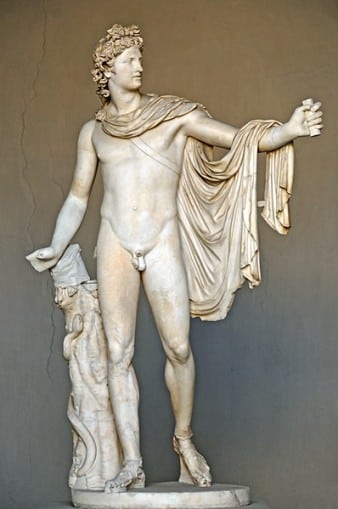
The origins of the name Apollo are unidentified. The name is written as Apollon (Ἀπόλλων) in the Ionic Dialect and Apellon (Ἀπέλλων) in the Doric. The Doric form comes before the Ionic, and it is related to an older *Ἀπέλjων. It may be associated with the month Apellaios and the festival apellaia, where young men were initiated.
However, the Greeks used to link his name with the verb apollymi (ἀπόλλυμι), which means “to destroy”. Plato’s work on the philosophy of language, Cratylus, contains references to Apollo being linked with apolysis (loss), apolousis (to be purified), aploun (simple). Many other authors contributed similar popular etymology theories. There is also no mention of it in the Linear B texts.
The Egyptians associated him with Horus, though their roles were different, whereas the Romans worshiped the same God with the same name, Apollo. Bragi, the God of Poetry, is the Norse equivalent of Phoebus.
Apollo’s Epithets – Greek and Roman
The Greeks and Romans both used many adjectives to describe Apollo, depending on which aspect of his nature they wanted to emphasize.
The god’s main epithet – which was actually used as a second name – was Phoebus (Φοῖβος), which means “bright”. Other epithets that denoted his association with the sun were Aegletes (“the sun’s light”), Helius (lit. “sun”), Lyceus (“of light”), and Sol (Latin “sun”).
He was a very skilled archer, something that is portrayed through epithets like Arcitenens (Latin “the one who carries bows”), Clytotoxus (“the famous archer”), and Hecebolus (“the one who shoots far”).
There were also many lesser epithets associated with his birthplace, like Delius, and with the places of his worship, like Actiacus and Pythius. The ever-young god was also called Acersecomes, for his playfully scruffy hair, and Chrysocomes, for his golden curls. Lastly he was also called Patroos, as seen from the temple in Ancient Agora.
The Seer
The god’s prophetic capabilities were denoted through many epithets, both Roman and Greek. The most significant were:
- Coelispex – the watcher of the sky (latin coelum [sky] + specere [watch])
- Iatromantis – the one who sees and foretells (Greek ἰατρός [healer] + μάντις [prophet])
- Loxias – the ambiguous speaker
- Manticus – the foreteller
- Proopsios – the one who can foresee or see for the first time
The Wolf
Legend has it that Apollo either killed or was metaphorically born by a wolf – in one way or another, he was associated with wolves. The epithet Lyceus mentioned above may not have had something to do with the word for “light”. The most common link is to Leto, Apollo’s mother. Leto was the patron goddess of the state of Lykia, and she was associated with the wolf, λύκος (lykos).
He was also called Lycegenes, which either means “born of Lycia” or “born of a wolf”. Finally, he was called Lycoctonus, which means “the one who kills wolfs”.
The Doctor
Apollo’s role as the healer was as prominent as his role as a prophet. This is evident from the epithet Iatromantis that we saw before. Other epithets that demonstrate his healing abilities include:
- Acesius & Acestor – the one who heals (from Greek “ἄκεσις”, healing)
- Iatrus – Greek for physician
- Medicus – Latin for physician
- Parnopius – from the word for “locust”
The Protector
Finally, he was the protector of many things. As such, he was described by epithets like:
- Agyieus – the protector of streets and homes
- Alexicacus – the one who wards off the evil
- Averruncus – Latin for the one who averts
- Epicurius – the one who aids
- Nymphegetes – the leader of the Nymphs, Guardians of Nature, meaning the protector of shepherds
- Sauroktonos – for killing the great Python outside the temple of Delphi
Apollo’s Origins and Family
Apollo is Artemis’ twin brother and the son of Zeus and Leto. Hera was envious of Leto and dispatched a large dragon named Python to pursue her around the world. Leto couldn’t find a place to give birth. The island of Delos, which finally served as Leto’s haven, was the only place that accepted the titanesse.
Leto later gave birth to Artemis, who assisted her mother in giving birth to Apollo. He grew to manhood in four days after being fed ambrosia. Hephaestus presented him with a bow as a gift. The young god, seeking vengeance for his mother, pursued and wounded Python. The dragon attempted to flee by hiding in the sanctuary of Gaea in Delphi.
Apollo polluted the sanctuary by spilling Python’s blood. To clear his name, the god of light decided to claim the Delphi shrine for himself. Thereon he, his sister Artemis, Leto, and Zeus were revered in the sanctuary.
Apollo’s Lovers
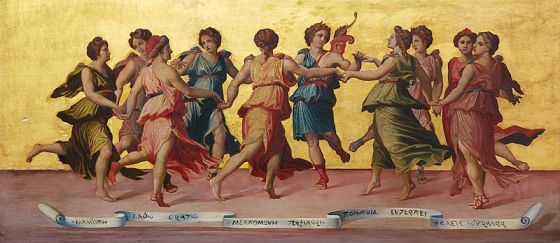
Apollo was an adored God with a plethora of love stories. Unfortunately, most of them have not been thoroughly catalogued. His most famous relationships are with Cassandra, Cyrene, Daphne, and Hyacinthus.
Another thing: most of these liaisons did not end particularly well.
Star-Crossed Lovers
Apollo takes the lead in a series of doomed love affairs. There are more failed love stories involving God than we would be comfortable describing. Let’s go over the most well-known ones.
The love denied
Quite a few deities and mortals refused the advances of the god, tricked him, or even abandoned him for another person.
Apollo bestowed the gift of prophecy on the renowned prophetess Cassandra for her to sleep with him. She refused to sleep with the god after he gave her the gift. Because he couldn’t take his gift back, he cursed her. From then on, even though she could always predict the future, no one would believe her.
Coronis and Marpessa were both mortal lovers who chose Apollo over their mortal lovers. Coronis fell in love with Ischys while she was pregnant with Apollo’s child, Asclepius. When Apollo discovered this, he became so enraged that he ordered Artemis to kill Coronis. Not only that, but he burned the feathers of the white crow that had informed him, turning crows black for the rest of time.
When Apollo fell in love with Marpessa, she was with Idas. Idas had already been through a lot to be with Marpessa. He didn’t even pause in front of the god before threatening him. Zeus stepped in and asked Marpessa to choose a lover. Marpessa chose Idas out of fear that the ever-young Phoebus would abandon her as she grew older.
Many other women attempted to flee him, including Bolina, Sibylla Kumaia, and Ocyrrhoe, who were all punished for refusing Phoebus’ advances.
The Metamorphosis
Surprisingly, three of Apollo’s lovers were transformed into plants.
Cyparissus was Phoebus’s young lover. Cyparissus had been given a pet deer by the god, which he accidentally killed. He was distraught. Cyparrisus begged his lover to let him mourn indefinitely. Despite his refusal, Apollo transformed the young man into a cypress tree, which came to represent grief and mourning.
Daphne was a young Naiad nymph who vowed to Artemis that she would keep her virginity until death. Apollo pursued her relentlessly and she always escaped him. She couldn’t take it any longer. Daphne requested assistance from her father, the river God Peneus. When the god tried to embrace her, Peneus transformed her into a laurel tree. Phoebus swore he would love her forever. He also made a wreath out of laurel leaves, which he would wear as a symbol of his unrequited love from then on.
Finally, one of Apollo’s greatest loves was Hyacinthus. The two men adored one another. The wind of the west, Zephyrus, was also madly in love with Hyacinthus. One day when he and Hyacinthus were playing with the discus, Zephyrus swayed the disc and killed the young man. Apollo was devastated. To honor his greatest love, he created a beautiful purple flower from some of the blood that was spilled from Hyacinthus’ body.
Apollo’s Love Affairs
Apollo had a great number of other consorts. Some of the most famous ones were:
- The Muses; it is said that Phoebus loved all of them, but because he couldn’t marry all nine, he chose to remain unmarried.
- Cyrene: a famous huntress with whom the god fell madly in love while she wrestled a lion. The god led her to Libya, where she gave birth to Aristaeus.
- Melia: an Oceanid who was abducted by the god. Phoebus killed her brother because he attempted to rescue her by burning down his temple.
- Urea: a sea-nymph that had an affair with Apollo during the construction of Troy’s walls.
- Sinope: a Naiad who was abducted by the god and taken to Assyria, giving her name to the town of Sinope.
- Chione: she slept with both Hermes, God of All Trades and Apollo and gave birth to Philammon (by Apollo) and Autolycus (by Hermes)
- Adonis, a mortal of unparalleled beauty: a stunning young man who was loved by both Apollo and Aphrodite
Other lovers include Aethousa, Amphissa, Chrysothhemis, Evadne, Hymenaeus, Leuconoe, Malaena, Phthia, Stilbe, and others.
Apollo’s Offspring
The god had many children – a few deities and many mortals.
Immortal Children
Apollo had only a few immortal children. Namely:
- Aristaeus, the patron of beekeeping and the manufacture of olive oil
- Asclepius, the god of medicine
- Chariclo, the nymph who married centaur Cheiron
- Samothracian Corybantes, the dancing daimones were in some accounts considered to be Apollo’s children
- Scylla, the sea monster was in some accounts the daughter of Apollo and Hecate, the goddess of magic
Mortal Children
Apollo had more than 50 catalogued mortal children. Some of the most well-known ones among others are:
- The seers Amphiaraus (oracular daimon), Iamos, Idmon (an Argonaut), Mopsos, and Trophonios (oracular daimon).
- The priests Branchos, Ismenos, Pythaeus, Teneros.
- The bards Eleuther, Linus (the teacher of Heracles), the infamous Orpheus whose music had magical properties, and Philammon.
- The kings and founders Amphissos, Chaeron, Dryops, Epidaurus, Erymanthus, Ion, Keos, Lapithes, Miletus, Syros, and Tenes.
- The princesses Eriopis, Hilaeira, Parthenos, Phoibe
Depiction and Characteristics
Apollo’s Appearance
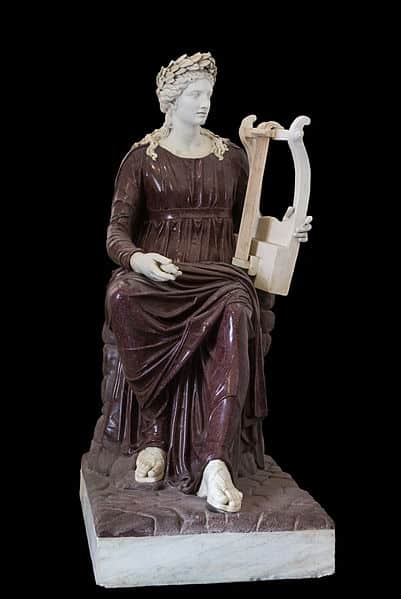
Apollo, the eternal ephebe, was portrayed as a very handsome, beardless young man. He was the most beautiful god, an embodiment of the ideal male beauty. Phoebus had an athletic, hairless body and messy, golden, curly hair.
He wore a laurel wreath on his head from time to time to symbolize his unrequited love for Daphne. He could be depicted fully naked or with a robe. Phoebus usually carried a lyre or a bow and quiver of arrows.
Apollo’s Personality
Apollo is described as a calm and just god who is always willing to help others. He adored his father and mother and was always there to defend them. He was the protector of many cities and clans, as well as a significant patron of the arts. Phoebus was also the one who gave medicine to humans and the act of prophecies, being a great benefactor to the human race.
As the symbol of eternal youth, he was good, truthful, and energetic. He is responsible to his lovers, cares for them, and tries to protect them – even if it doesn’t always work out. Ovid, on the other hand, depicts him as a victim of his passions, both in his love life and in his attitude toward others. That can also be a trait of a man who is perpetually young.
Being an incredibly handsome god, Apollo was somewhat vain and conceited. He could also be stubborn and even wrathful when people disrespect him or his family. He is known to have harmed many people who opposed his mother and sister, including Niobe. As a conceited god, he was also enraged by hubris or anyone who did not do exactly what he wanted, such as Cassandra.
Overall, he may be cruel, but he is never unjust. Apollo never hurt anyone without reason, and he has greatly aided his family, lovers, and humanity as a whole.
Apollo’s Powers
As an Olympian, Apollo possessed all of the Gods’ common abilities: he was immortal, invulnerable, possessed superhuman stamina and strength, was omnipresent, and was eternally young. He could also bless or curse mortals and was a shape-shifter.
Aside from these, he was a very complicated deity. Apollo was one of the most powerful and revered deities among both Greeks and Romans. He was a skilled archer with prophetic abilities. He made predictions through oracles, which allowed the gods to speak directly to mortals.
Apollo’s music could heal people, but he could also inflict plagues and diseases with his arrows, as he did during the Trojan War.
Apollo’s Sacred Symbols
Apollo’s sacred symbols included his bow and arrows as well as his lyre. Hephaestus gave him his bow when he was still young. They represent the slaying of the Python and the plague inflicted on the Trojans by the god.
The lyre, his most famous symbol, represents his role as a patron of the arts, particularly music. After stealing his cattle, Hermes gave Phoebus his lyre as a gift of reconciliation. The lyre could turn other items into musical instruments. The music of Apollo could also heal mortals.
Apollo’s Sacred Animals / Plants
The python, wolf, and raven were among Apollo’s sacred animals. The python was a massive serpent sent by Hera to pursue Leto while she was pregnant with twins. He later avenged himself by killing the snake.
The raven (or crow) represents his rage. After the raven told him that Coronis had slept with Ischys, the god scorched its wings. As a result, the god shot the messenger, turning every raven black from then on.
Surprisingly, the god is also associated with wolves. Apollo is linked to wolves in a variety of ways aside from his role as wolf-hunter and flock protector. It is said that a pack of wolves accompanied Leto to Delos and helped her give birth. Leto came from Hyperborea, a mystical northern land for Greeks and Romans where Apollo would go to be close to the wolves.
Finally, the swans were the “singers of Apollo”. Being the most musical of all the birds, they carried his chariot to the Hyperborea.
The plants, meanwhile, represented his doomed love stories: laurel, cypress, and hyacinth.
Apollo’s Roles and Responsibilities
As we’ve seen, Apollo is a complicated deity. His roles and responsibilities are extensive. First and foremost, as the god of music and the arts, he was a powerful and inspirational figure. He was closely associated with the Muses and was summoned by any artist, particularly musicians, to assist them.
He was also in charge of the oracles. Most prophecies told in Ancient Greece were allegedly given by him and expressed through seers and priests in the oracles. He was specifically in charge of the great oracle of Delphi, which was the largest oracle of antiquity.
Apollo was also the protector and nurturer of children and young men. He was in charge of both their education and their passage into adulthood.
He additionally served as the god of healing, as he was the father of Asclepius, the great god of medicine. Even his music was said to be able to heal people. He could not, however, heal everyone, as evidenced by all the people who died in his hands, such as Hyacinthus.
Myths
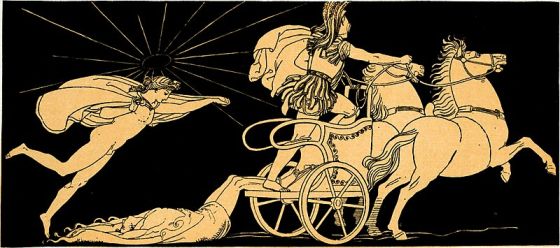
Apollo The Slayer of Giants
He was a skilled archer who slaughtered many giants. He is famous for killing the colossal serpent Python and the giant Tityos. Hera sent them both to kill his mother, Leto.
He also faced Aloadae, the twin giants named Otis and Ephialtes who attempted to attack Olympus. Apollo killed them by shooting them with his arrows. He also killed Phorbas, a ferocious giant who attempted to plunder Delphi’s oracle.
Niobe’s Children
In his quest to protect his mother, Apollo was tenacious. Niobe was a Theban queen that had fourteen children. She boasted to be superior to Leto who had only two children. She also made fun of Apollo and Artemis for being effeminate and manly, respectively.
Leto was offended and told her children to punish Niobe. Apollo murdered the seven sons and Artemis murdered the seven daughters. According to legend, Chloris was the only daughter who survived because she prayed to Leto. When she gave birth to Nestor, Apollo bestowed upon him the years he had taken from Niobe’s children. Nestor would live for three generations.
Heracles
In a fit of rage, Heracles murdered his friend Iphytus. He contracted a terrible disease and decided to seek advice from the Oracle of Delphi. Because the priestess couldn’t help him, he became enraged and began destroying the temple. He also stole the Delphic tripod with the intention of creating his own oracle.
For the tripod, Apollo wrestled the hero. Following the incident with the Ceryneian Hind, Artemis aided her brother. Heracles was helped by Athena. Zeus intervened, Apollo kept the tripod, and Heracles went to be a slave for a year for Omphale, queen of Lydia.
Trojan War
Apollo was on the Trojan side almost from the start of the Trojan War.
When Agamemnon kidnapped Chryseis, the daughter of Chryses, an Apollo priest, the god was furious. He inflicted a plague on the Greek camp with his arrows. Agamemnon, The Mighty King and Central Figure of the Trojan War then released Chryseis but captured Briseis, infuriating Achilles, The Mightiest Champion of The Trojan War.
Apollo shielded Trojan warriors several times. He saved Aeneas, the Trojan hero, Aphrodite’s son, by covering him with a cloud. He rescued Zeus’ son Sarpedon’s corpse, cleaned it, and gave it to Hypnos, the god of sleep (Sleep) and Thanatos, the god of death. Agenor, Glaucus, The Tragic Sea God, and Polydamas were also helped by him.
Apollo also frequently assisted Hector. He healed him, shielded him from Achilles, and assisted him in killing Patroclus. He even protected Hector’s corpse and pushed Achilles away after Achilles killed him. Achilles enraged the god because he had already murdered two of his sons, Tenes and Troilus. Phoebus was responsible for Achilles’ death by directing Paris’ arrow into Achilles’ heel.
Music Contests
Apollo punished many others who committed hybris by challenging him to musical contests. Pan challenged the god to a contest, where Tmolus the mountain god umpired. Pan played the pipes, and Apollo played the lyre. Tmolus declared Apollo the winner right away. Everyone was happy except Midas, Pan’s devoted disciple. As a result, the god transformed his ears into donkey ears.
Marsyas, a satyr, picked up an aulos that Athena had tossed because it made her face look puffy. She cursed the instrument as well. Marsyas, in a frenzy, challenged Apollo to a contest judged by the Muses. Apollo triumphed and executed the satyr by flaying him. Linus and Orpheus, the most skilled musicians of antiquity, then discovered the strings.
Cinyras, king of Cyprus, challenged him to a duel after Agamemnon cursed the first. Apollo defeated Cinyras, and he either committed suicide or was killed after.
Admetus & Slaying of the Cyclops
Apollo, when Zeus exiled him from Olympus for murdering Python, The Ancient Serpent, went to serve Admetus, king of Pherae. They allegedly had a romantic relationship, as described by Ovid. Apollo always helped him. He assisted him in marrying Alcestis, The Woman Of Sacrifice and soothed Artemis when Admetus forgot to give her offerings. Admetus died young and Apollo either persuaded or tricked the Fates into allowing Admetus to live.
When Zeus killed Asclepius for “resurrecting the dead,” Apollo sought vengeance. He killed the Cyclopes, One-Eyed Giant Monsters because they created Zeus’ lightning bolt, which was used to kill Asclepius. Zeus intended to send his son to Tartarus as punishment, but Leto intervened. Zeus instead ordered him to serve Admetus for another year.
Apollo in Ancient Greek Religion
He was a universally loved deity. He was revered by both Greeks and Romans as the patron and protector of many people and things.
Sacred Sites
First and foremost, there is the famous Temple of Apollo in Delphi’s sanctuary. It also housed the world’s largest oracle, the Oracle of Delphi. Another well-known temple is in Portara, Naxos.
Arcadia is home to the Temple of Apollo Epicurious (now Messenia). It has been well preserved to this day, and is widely regarded as one of the most beautiful temples.
Antioch, Athens, Corinth, Cyrene (now Shahhat), Euboia, Epidaurus, Gortyna, Miletus, the Palatine Hill of Rome, Pompeii, Rhodes, and Syracuse all have Apollo temples.
Worship & Festivals
The Pythian Games were Apollo’s most important festival in Ancient Greece. Held every four years, they included athletic competitions as well as the most important musical competitions. Delia was also celebrated on the god’s home island of Delos. Every year, the Romans celebrated the god in Ludi Apollinares.
Other known festivals were:
- Actia (Nicopolis, Epirus)
- Boedromia (Athens)
- Carneia (Sparta)
- Daphnephoria (Thebes)
- Hyacinthia (Sparta)
- Metageitnia (Athens)
- Pyanepsia (Athens)
- Thargelia (Athens)
Try The Apollo Crossword
Do you like crosswords? Then play this game and test your Apollo knowledge!
You can also play around with Apollo’s and other Olympian gods’ names in this fun anagram game:
Don’t forget to try our other games as well! For example, this game about Leto, the mother of Artemis and Apollo.
Representations of Apollo in Art
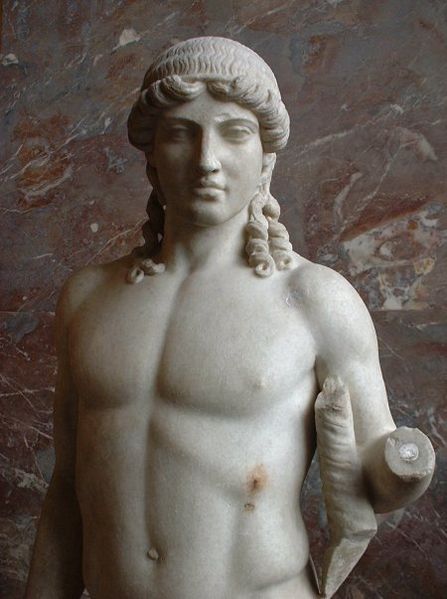
Apollo is a popular artistic theme among Greeks and Romans alike. As a powerful but also an exceptionally attractive god, there are numerous sculptures depicting him and his – usually naked – body.
The Apollo of Mantua and the Apollo Citharoedus were the most popular statues of the god. For centuries, the statue of Apollo Belvedere has represented the pinnacle of male beauty. Another well-known sculpture is Gian Lorenzo Bernini’s (1625) baroque marble statue of Phoebus capturing Daphne.
He also appears in many paintings from the Renaissance and later, usually with his lovers. We can see “Apollo and Daphne” (Giovanni Battista Tiepolo, 1971) and “The Death of Hyacinth” (Jean Broc, 1801). Raphael painted “The Parnassus” in 1511, depicting him with the Muses.
In The Old Texts
He holds one of the central roles in Homer’s “Iliad,” as he has a heavy impact on the troubles within the Greek camp and is the protector of Trojans, particularly Hector. Of course, he is extensively discussed in Homer’s Hymn to Apollo. Many other historians and poets, including Pausanias, Herodotus, and Hesiod, have written about him.
The god is also prominent in many ancient Greek tragedies. In Aeschylus’ trilogy of the Oresteia, for example, he is the one who initially decides Orestes’ fate.
However, information about Phoebus is most apparent in works of Latin lyric poets. Ovid’s magnificent works, such as Metamorphoses, contain extensive documentation of the god’s love stories. Statius and Hyginus both mention him in their works.
FAQs
He was the god of the sun, music and arts, of healing and disease, the founder and protector of tribes and cities, as well as the god of prophecies.
Zeus and Leto.
He took the Trojan side.
Daphne was turned into a laurel tree, Hyacinthus into the hyacinth flower, and Cyparissus into a cypress tree.
Either with Baldur, the God of Light, or Bragi, the God of Poetry.
Sources
Aeschylus
- Oresteia
Hesiod
- Theogony 404
- The Great Eoiae Fragment 16
- Works and Days 770
Homer
- Odyssey 6.100
- Iliad (many parts of books 1, 16 20, 21)
- Homeric Hymn 3 to Delian Apollo
- Homeric Hymn 3 to Pythian Apollo
Nonnus
- Dionysiaca 3.153
Ovid
- Heroides 15.23
- Metamorphoses 1.452, 6.122, 10.106, 10.162, 11.310
Pausanias
- Description of Greece 1.43.7
Pseudo-Apollodorus
- Bibliotheca 1.16, 3.10, 3.16
Statius
- Thebaid
Featured Image Credit: John Flaxman Jr., Public domain, via Wikimedia Commons

